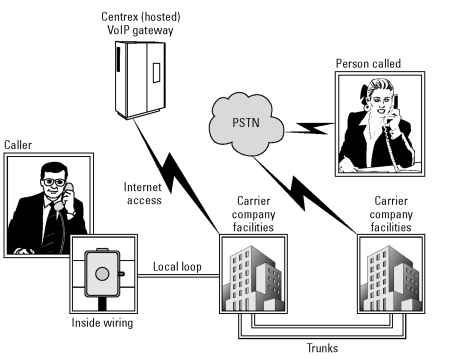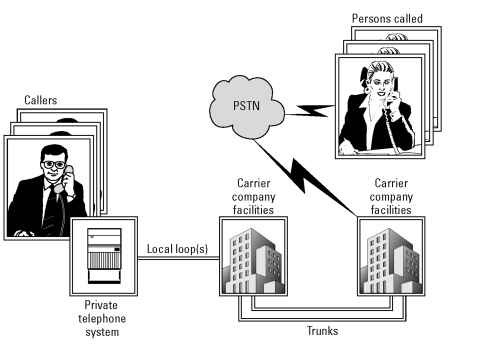Computer data networks and circuit-switched voice networks are completely separate, with individual staffing, billing, maintenance, and accounting systems. Although the maintenance costs of computer networks are affordable for most companies, the recurring charges for traditional forms of telephony are huge for small, medium, and large multilocation companies. VoIP is designed to converge (integrate) a company’s voice needs onto the company’s existing computer network. If a company does this, they can eliminate most (if not all) recurring circuit-switched telephony charges.
In the past, the POTS world had only two types of services: local and long distance. Local service covered the entire metropolitan area, with no distinctions for the various levels of toll service that we have today. In the early days of the telephone, long-distance cost customers dearly. A call from New York to the west coast might have cost $3 to $4 per minute. Today, that same call might cost a consumer $.02 to $.05 per minute and a corporate caller $.01 to $.03 per minute. The corporate customer is most likely on some sort of dedicated private network consisting of a phone system connected to the
PSTN.
It might appear that the cost of telephony today is dirt cheap in historical terms. This would be a mistaken conclusion. In addition to the carriers getting more organized and the government increasing its regulation of the telecommunications industry, many changes have evolved. These changes have increased your bottom-line telephone bill and increased the number of line items on that bill.
Now, instead of just two types of phone service offered on the PSTN (local and long distance), we have five: local, intralata, intrastate, interstate, and international. Each of these is discussed in detail in topic 3. These five services are based on the origin and destination of a call, using the LATA and NPA-NXX to determine those locations. In addition, the same system is used by the government to place various surcharges and fees on each telephone access line.
No one would argue that the quality of carrier-switched telephony is excellent. However, the system that has evolved for charging telephony customers leaves much unsaid and a lot to be desired. Except for local calling, VoIP can reduce or eliminate the charges of the other four categories.
To lessen the burden of newer and diverse telephone costs, many companies have acquired their own POTS-based telephone systems. Company-sponsored telephone systems can reduce the monthly bill that consumers and companies pay for telephony services. Four different telephony system models have evolved in the past three decades.
The first model, POTS, has already been described; it is the use of telephony access lines and carrier services over the PSTN through a carrier. The other models are the Centrex, KTS, and PBX models. Each of these are discussed in this sections.
The Centrex model
The second model is the central office exchange service, or Centrex, model. Centrex is physically set up the same as the POTS access line model. Like POTS, Centrex uses the same physical twisted-pair copper lines.
The difference between the POTS and Centrex models lies in how the line is terminated at the carrier company’s facility. Instead of getting switched into the PSTN directly, the Centrex line first goes to the more intelligent mainframe-level telephone system owned and operated by the carrier. From there, the system can provide the customer with many more features not directly available on a plain POTS line. To get these features on a POTS line, the customer typically has to pay for each feature. Centrex provides a bundle of features with little or no added charges.
Because you get more with Centrex, you pay a little more for the line on a per-line per-month basis. Centrex is a good alternative for companies operating out of temporary facilities (such as a lease situation) and for companies that can’t or don’t want to maintain a full-blown telecommunications infrastructure. When you lease a Centrex system, maintenance is usually included, which reduces the need for skilled staff on the company payroll. Figure 2-7 shows how the addition of a Centrex system modifies the model originally shown in Figure 2-1.
The good news is that a VoIP solution exists for the more traditional Centrex situation: VoIP Centrex. You need a computer network in the temporary premises, but that is an expense you can unplug and take with you when you move to your permanent location. With VoIP Centrex, you can start your VoIP network, acquire features galore, and get the maintenance services you need. When you move to your new, permanent location, you simply plug in your network, and you are up and running.
Figure 2-8 shows the addition of VoIP Centrex to the mix.

Figure 2-7:A typical Centrex telephone connection over a POTS line.

Figure 2-8:VoIP Centrex, sometimes called hosted VoIP.
With any Centrex option, you pay more per month in return for avoiding the need to sink costs into your own infrastructure. Also, by using the Centrex host’s facilities, you get a rich feature set with no additional monthly charges. Another benefit is that you can walk away from a Centrex solution anytime you want without penalty. Although some smaller companies keep Centrex forever, most growing companies eventually convert to one of the models described in the following section.
The KTS and PBX models
The other two system models are private telephone systems installed on the company’s premises. Low-volume customers often use a key telephone system, or KTS. High-volume, larger companies often use a private branch exchange, or PBX. These two are a departure from the POTS-line model, where a line is run to each phone on the premises. As such, they are also a departure from the Centrex model, which uses the same type of access line
as POTS.
Figure 2-9 illustrates how a typical private telephone system would change the phone mix.

Figure 2-9:A typical private telephone system connection.
One big benefit of private telephone systems is that they reduce the number of required access lines. For example, the industry standard is one access line for every six to eight employees who have a telephone. Any reduction in the number of access lines represents an enormous cost benefit for companies when compared to the POTS or Centrex models. In addition, private telephone systems enable the company to provide most traditional call features, such as voice mail, call forwarding, call transfer, and conferencing, to any telephone in the company — at no added cost.
